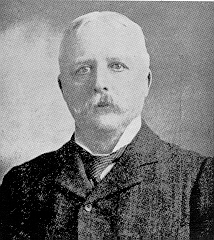

George Shea was born in St. John's on 4 July 1851, the son of Edward and Gertrude (Corbett) Shea. After receiving his early education at St. John's and Appleforth, England, in 1870 he joined the St. John's firm of Shea & Co. as a clerk. Owned by his uncle, Ambrose Shea, Shea & Co. were shipping and commission merchants and local agents for the Montreal-based Ross and Allan steamship lines. When Ambrose in 1886 assumed the governorship of the Bahamas, George became the company's managing partner; upon his uncle's death in 1905, he became its owner. George married twice: first, in 1888 to Louisa Catherine Pinsent; second, on 18 July 1900 to Margaret Rendell, the first Newfoundlander to become a trained nurse as a graduate of Johns Hopkins Hospital in Baltimore.
Shea came from a family with a long association with Newfoundland politics. In 1885 he won election by acclamation as a member of the Roman Catholic Liberal Party for the district of Ferryland; in 1889 he was victorious as an independent but lost the seat four years later. In 1897 he again represented Ferryland, this time as a member of the Tory Party. From 1897 to 1899 he served as a minister without portfolio in the government of Tory Premier James Winter. He did not seek re-election in the 1900 election.
In 1902 he reluctantly acceded to appeals from some prominent citizens and ran in the first mayoralty election held on 19 June in St. John's. In the contest he defeated labour candidate Thomas White, who also had the support of railway owner Robert Reid. During his mayoralty, Shea brought financial stability to the town's finances, which for a decade had operated on a deficit basis, implemented major improvements to the water system, and appointed the first medical health officer for St. John's, Dr. Robert Brehm. Despite these achievements, on 26 June 1906 Shea failed to retain the mayoralty, losing to the popular labour lawyer, Michael Gibbs.
Two years earlier Shea had re-entered colonial politics as one of three Liberals for the three-member district of St. John's East. From 1904 to 1908 he was a minister without portfolio in the government of Liberal Premier Robert Bond. In the 1908 and 1909 general elections, Shea and his two Liberal colleagues in St. John's East successfully withheld a challenge from Mayor Gibbs who headed the People's Party ticket in that district. While Shea did not run in the 1913 election, he remained an influential figure within the Liberal Party. In 1917 and 1918 he led attempts by Liberals to convince the retired Bond to return to lead the Party in a pending election. When Bond rejected these overtures, Shea threw his support behind Liberal Richard Squires who won the 1919 election.
Shea's reward was an appointment as minister without portfolio in Squires' cabinet and in 1920 a seat in the Legislative Council. During the 1920s he occasionally served as Acting Premier when Squires was absent from the Island. He was also a Governor of the Newfoundland Savings Bank and Chairman of the Permanent Marine Disasters Fund Committee. He died in St. John's on 13 September 1932.